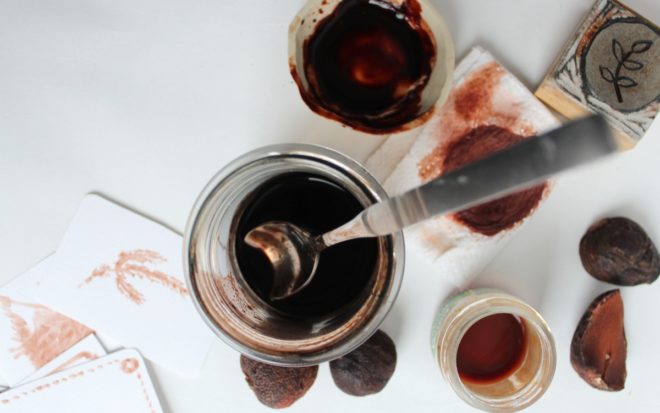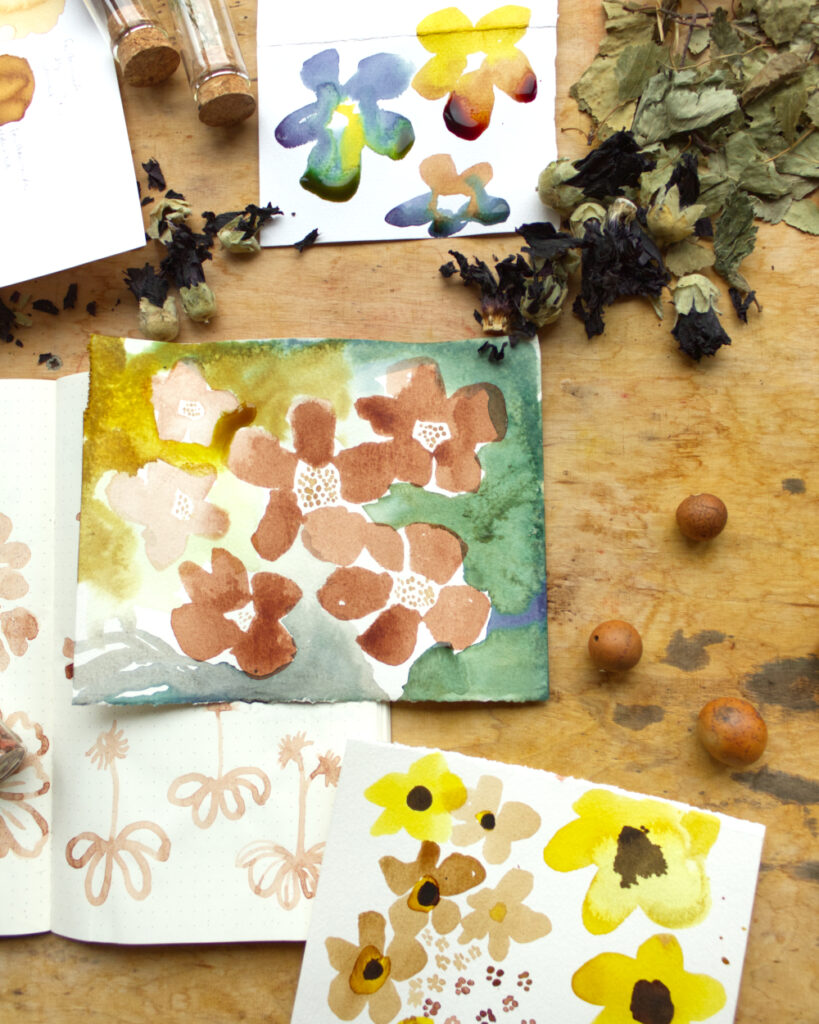Your basket is currently empty!

DIY: Make ink from plants
Just like before easter I also got creative again this festive season: I wanted to make ink from plants that to draw christmas cards and gift tags. Preferably from plants that are easily available. A few days after thinking about this, an avocado appeared in our kitchen, and that's when I knew what to do.* Make ink with waste from avocado!
Of course I just had to do this while I was busy with christmas preparations. But maybe you too can use a little creative project to slow down!
For my inks I used the fresh seed and skin of one avocado. As with dyeing, you could use dried or frozen seeds instead. And you don't have to use booth seed and peel together. I just used both fresh shortly after the avocado was eaten. And you can definitely yield quite a bit of ink using just one avocado (or its waste to be precise).
*If you don’t like to buy avocados, or if you just don’t like to eat them, you can ask in a restaurant or café if they can save some seeds for you. Just make sure to pick them up quickly so they don't start to get moldy.
What you need to make ink from plants
- skin and seed from one avocado
- washing soda is nice to have but you can do without
- a small pot (not necessarily a dedicated dye pot if you use just avocado waste)
- a small sieve or similar
- a jar with a lid for storage
- paint brush or pen
Ink from avocados No. 1: Basic recipe

For my first attempt, I chopped the seed and tore the peel into smaller pieces. I covered the pieaces with a little water in my pot, heated them briefly and then left them to soak without further heat. I didn't want to use a lot of energy on this project, so for the next two days I used the heat on top of the stove from baking in the oven to intensify the color of the ink. If you heat your ink a lot, watch the water level. If a lot of water evaporates, add some more. But not too much so that your ink doesn't water down.
Once you're satisfied with your colour intensity, strain your ink with a fine sieve, or a cheesecloth.
You can now try drawing with your ink, or carefully heat it to reduce the liquid further. I did heat it briefly because the color wasn't as strong as I desired.
Schneller + dunkler, Tinte aus Avocadokernen Nr. 2: Mit Waschsoda

For my second attempt, I used the same seed and peel again. Aside from water I also added a small amount of washing soda. Although I had used the plant matter before, the ink here got darker then before, and much faster.
Washing soda has an alkaline pH and you will only need a very small amount of it. You will see its effect quickly! The dye in avocado seeds and peel are among those that do well with an "alkaline extraction". The alkaline pH not only influences what the ink looks like, but also helps to quickly coax more dye from the plant matter.
So if you have washing soda at hand, I would highly recommend it!* I also like the stronger color very much, but above all it is faster. You might only need to heat this ink very briefly.
It amazes me how much dye is in the seed + skin of just one fruit! If you need more ink, just repeat the process. I let this ink soak for three days, during which time I only used the excess heat from baking bread for the pot to heat it.
Washing soda is sodium carbonate, and you can find it in drug stores next to detergents or washing powders. When you use it, follow the instructions on the packaging and avoid getting it in your eyes.
*Perhaps you have other alkaline additives in the house to subsstitue. You could also try baking powder or baking soda. (Not sure it works as well, I always use washing soda).
Thickening your plant ink

Ink from avocado seeds will probably quickly thicken a little anyway if you reduce them on low heat.
But there are also various natural thickeners that have long been used for inks. They can also prevent solids in the ink from settling on the bottom quickly.
I used ground gum arabic for this. I wanted a slightly thicker ink to use with my stamps - I didn't have a good ink pad for it, just kitchen towel. If you want to make stamping ink, you should look for a suitable material for an ink pad first. That should definitely improve your results, I just was too impatient.
You could also experiment with other resins, starch, honey, gelatin ...
Storing botanical ink
The ink can be kept cool and tightly sealed in the refrigerator for days to weeks. That also depends on the plants used and on whether and which ingredients were added.
Some essential oils, like clove oil, also help prevent mold. You can put a drop or two of it in your jar with ink. Please dose sparingly and also observe the safety instructions on the packaging of essential oils. Essential oils are extremely concentrated and should therefore be used very carefully.
Ich gebe inzwischen immer einige Tropfen Nelkenöl in meine Tinten, und kann sie so gut ungekühlt im Atelier aufbewahren.
Du könntest stattdessen auch ein oder zwei Nelken in die Tinte geben.
Färben mit Küchenresten und andere Pflanzen zum Ausprobieren

For further ink adventures with home ingredients, consider using yellow or red onion peels. Or pomegranate peels, black tea grounds and the green husks of walnuts again next autumn.
All of these plants are rather easily accessible at least here, and end up in the compost anyway. Before that happens, you can still use them to dye! Or, in our case, make ink.
I would collect a little more of the black tea that has already been used for the project, because unlike the other ingredients, it has already been infused once before.
You may notice that I don't like to use whole foods to dye, but rather their waste, even if it's just to make a little bit of ink.
Auch die Pflanzen aus meinem Färbergarten nehme ich gern für Tinten, bei frischen Blüten reichen oft schon ein paar Handvoll für intensive Farben. Und auch beim Staudenknöterich-Experiment gab es Tinte!

Colourfastness of plant dyes
But the plants (or their waste) listed here are not only a good choice from a zero waste perspective. They all contain certain types of dyes that naturally have a fairly good fastness. Onion peel and walnut shell have special dyes that are able to combine with fibers even without stain (substantive dyes). And avocado skin/stones, pomegranate peel and black tea contain tannins. Plants can contain various types of tannins and these can make dyes more colourfast.
This ink sure doesn't last forever, but it won't fade in a very short time either.
Fugitive dyes – not all plants are dye plants
There are some plants in the kitchen that are quite colourful but don't have these characteristics that make a good dye. Things like spinach, beet root, red cabbage, various pink and blue berries contain fugitive types of dye. The are colourful when we look at them, but just don't contain proper dyes. Personally I'd rather eat these as dyeing with them feels too wasteful when the colours don't stand washing or sun light. But for a small project, perhaps with young children, they might still be worthwhile!
Plant inks and mordants
Ich wollte meine Tinte erstmal einfach und auch „kindgerecht“ halten. Wenn du dich mit dem Färben schon auskennst, und Beizsalze hast, kannst du aber auch damit experimentieren. Die Kombination aus Beize und Farbstoff kann wie beim Färben auch bei der Tinte die Farbechtheit verbessern.

I have also added some homemade iron solution to my avocado ink. As expected, the color becomes much darker immediately. But the iron avocado ink also tends more to settle on the bottom. If that bothers you, do without the iron or add some gum arabic.

I liked drawing with the ink so much that I've already started the next one! This time with walnut husks that I always have in the studio for dyeing – switch for black walnuts if these are local to you.
Ich habe früher viel gezeichnet und auch mit Acrylfarben gemalt. Weil ich die Materialien nicht mochte, habe ich mit der Zeit einfach damit aufgehört. Mit Farbe gearbeitet habe ich stattdessen beim Färben mit Pflanzen. Diese einfache DIY-Tinte hat sicher nicht die Beständigkeit vieler gekaufter Farben, dafür weiß ich was drin ist. Für mich schließt sich da ein Kreis, und ich mache inzwischen öfter mal Pflanzentinten!

Comments
2 responses to “DIY: Make ink from plants”
-
Hi,
ich bin auch seit einiger Zeit auf das Malen mit Naturprodukten gekommen. Insbesondere durch Rebecca Desnos (Blog und Buch). Wenn du jedoch eine schöne braune Farbe suchst bzw. diverse Brauntöne, so empfehle ich dir auch einfach löslichen Kaffee. Der lässt sich wunderbar verändern durch Zugabe von Wasser oder auch wieder punktuell abnehmen, etc. Auch angedickt mit Gummi Arabicum gut für Stempel geeignet. Ich mische auch gern etwas Kurkumapulver unter und liebe den Effekt, der durch die winzigen Pulverpartikel entsteht. Ich finde eben die Mühe mit den Avocados zu viel, wenn man diese Farbe auch mit Kaffee bekommt. Wenn du allerdings den Rosa Farbton wünscht, dann kenne ich da auch nur die Avocados. Es freut mich jedenfalls, dass natürliche Farben immer mehr Anklang finden. Auch wenn sie nicht so lange halten. Aber wenn ich eine Karte bemale für einen Geburtstag oder Weihnachten, so ist diese ja eigentlich auch nicht für die Ewigkeit gedacht. Ich freue mich über solche Posts. Schöne Feiertage!-
Oh, danke für den Tipp, mit dem löslichen Kaffee ist’s natürlich eine Expressvariante! Den hab ich nie zuhause, aber wenn man den eh im Schrank hat ist das natürlich super.
Und ja, für die Ewigkeit sind die Farben nicht. Aber ich dachte gerade, an die Box, in der ich schöne Post- oder Grußkarten aufbewahr. Alle Jubeljahre schau ich da mal rein und freu mich. Und ich glaube, da würden sich diese Tinten tatsächlich auch sehr gut machen 🙂
Schöne Feiertage wünsch ich dir auch!
-
Leave a Reply